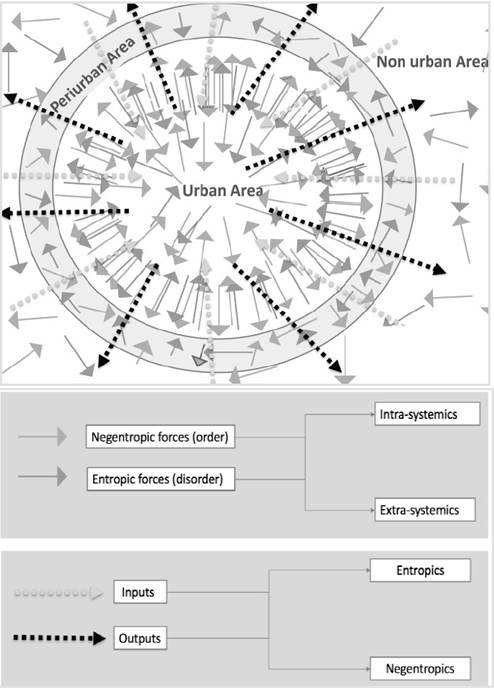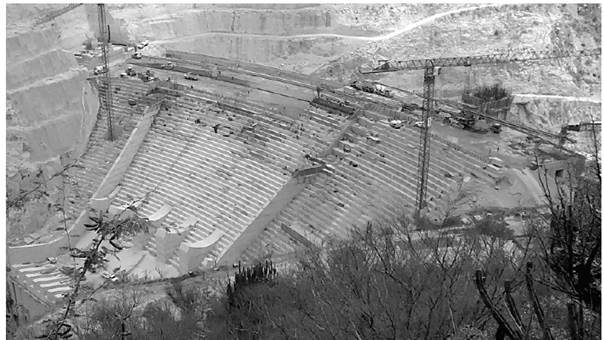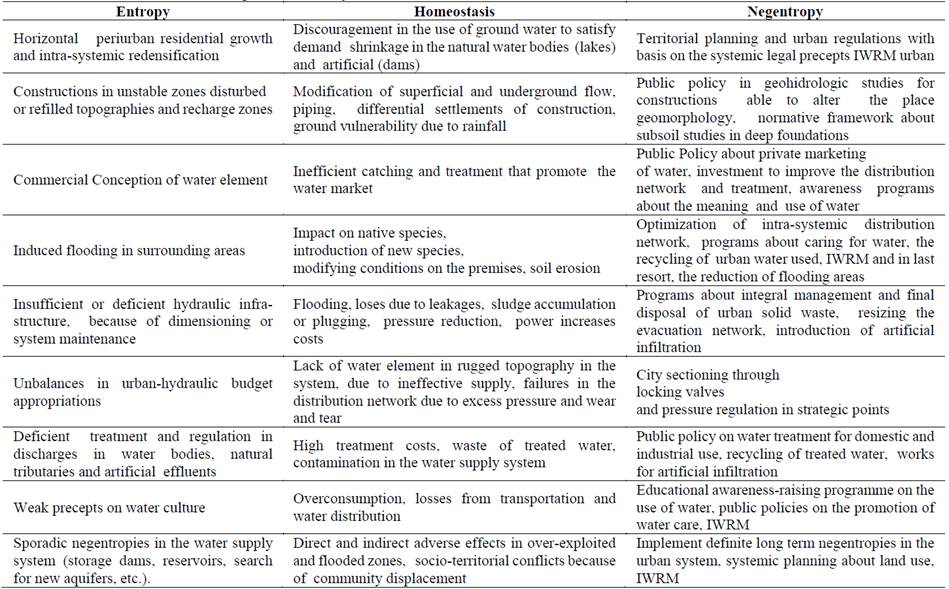1. Introduction
In the last few years, it has been possible to determine through simple direct observation, the changes in ground use caused by antropic forces which have occupied, exploited and transformed many times with irreversibly the original system consitions and its surroundings. In the light of this urbanization process, the soil has been considered a scarce element that not only represents a physical or geographical support for the establishment of urban and population activities, but also an element of the territory that acquires value [1].
In the urban system, the changes in ground use have been promoted by absence of regulations in planning and residential construction, focused in formalizing the redensification paradigm. On one side, in the system boundary and its immediate surroundings the setting becomes much more complex, due to the housing growth which is generally horizontal, and that advantageously exploits the ground reserves allocated for agriculture, cattle raising or water recharge, latter as an element, not as a resource. This setting has complicated the interaction between the inter-systemic and intra-systemic processes which accelerate the levels of entropy (state disorders) that systems go through [2].
On the other hand, social systems are peculiar in the way they transform raw materials coming from the natural elements, into products, services and waste [3] Fischer y Haberl, 1998). In such a way, that ownership and excretion represent the initial and final stages of the environmental metabolism [4]. To sum up, the economic activities and society represent a dynamic component that takes action from the interior of the eco-systems [5]. While the term inter-systemic refers to the relationship urban systems and non-urban systems (surrounding systems); the term intra-systemic expresses the relationship between the constituent elements of the system [2].
(…) the complexity of the natural processes, cultural, social and economic which are involved in the assessment, demand and systemic orientation, are taken into account since only this way you can reach broad explanations about the causes which originated the problems and, thus, more certainty will be obtained on these issues to look for possible solutions [6].
In this context, good part of the surrounding urbanization process is caused by real estate developers following the principle of supply and demand. Sometimes necessary, but many times induced by price sale speculations. In this way, considering the budgets of the so-called Urban political ecology, the urbanization becomes in the cause of many of the problems environmentals [7].
(…) the metropolitan cities have experienced a greater requirement in hydraulic works and, consequently, higher costs in the collection, treatment and distribution of the same. This has led the Mexican government to implement a series of modern actions in rural areas through investments in water works based on the cost-benefit principle, for the benefit of some people and the detriment in quality of life of others [8].
In Mexico for example, the government’s capacity is insufficient to supply the outskirts urban systems where “the axis of the urban regional policy has turned into urban sprawl has developed diverse slums with important socioeconomic differences which are reflected in their architectural designs” [9].
In reality, to live in the outskirts represent initial advantages associated with the buying price, nevertheless, very soon you will experience disadvantages in diverse basic services such as education, security, mobility, health, water and sanitation. As far as access to water element for example, some sections in the outskirts have water cuts which sometimes last several days (Fig. 1).
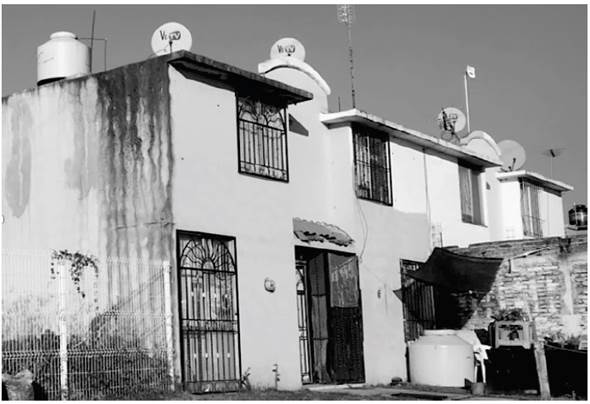
Source: The Authors.
Figure 1 Entropies in the outskirts of Guadalajara, Mexico: water tanks in the garage.
Based on the previous discussion it has been said for decades “this situation related to water works has become a crisis” [6]. In this sense, we suppose that the answers have not worked properly, in other words they would represent short term negentropies (reductions in government lack of order). Because of this, this investigation questions how to reach a system surroundings equilibrium when it comes to water works. From this perspective, the objective consists in reviewing through the systems focus the decisions geared to pressure the surroundings that are part of the hydraulic project known as El Zapotillo dam. However, “The dispute over the flood of three villages near the site of the macroproject (…) manifest clearly a high degree of intractability (…)” [10].
This dam aims to minimize temporarily the water requirements for part of the cities of León in Guanajuato and Los Altos and Guadalajara in Jalisco, Mexico (Table 1). The area of the basin that circumscribes the project is 17,775 km2, average runoff annual of 440 millions of cubic meters, flow average of 13.95 m3/s, pourer of the mixed dam (Reinforced concrete face and concret compacted with roller) of 200 meters long and designed in free crest with jump sky and buffer tank [11-12].
Initially the project considered a curtain height of 80 meters and a set of complementary works (Table 2). However, the titular of the Commission State of Water (CEA) has maintained the thesis that said height isn't functionally viable. From there the decision to take it to 105, even when, that implies inevitably the flood of the villages of Temacapulín, Acasico and Palmarejo [13], situation before which the inhabitants of these three localities have initiated judicial proceedings in 2008 under the amparo proceedings 2245/2008 and 2262/2008, considering that the construction of El Zapotillo violated guarantees enshrined in the Political Constitution of Mexico.
Table 1 Distribution of water available of the Green River for state of Jalisco and Guanajuato according to reserve decree modified in 1997

Source: The Authors.
Information reported by [11-12] was used.
Table 2 Technical datas of the modification of the El Zapotillo Project
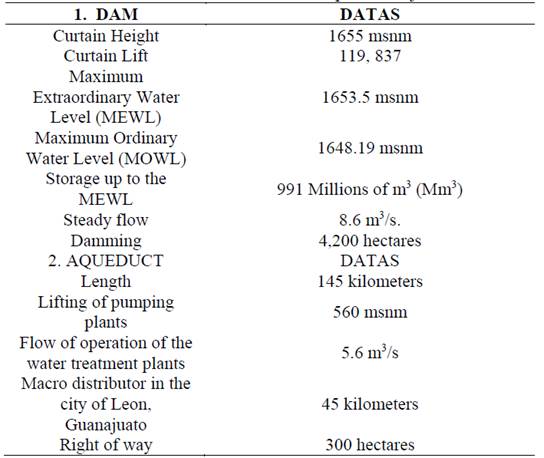
Source: The Authors.
Information reported by [11-12] was used.
Today, El Zapotillo dam is stopped in its construction on the river El Río Verde, in the section from Cañadas de Obregon to Yahualica town, through the order of suspension granted by the Second District Court on Administrative Matters in the State of Jalisco.
Methodologically this study was structured in four stages:
a) Firstly: it was done a description of the relationship between the system and its surroundings with the entropy and negentropy intra-systemic and inter-systemic, due to “(…) is accepted that from its surroundings (beyond the city limits) come in and go out currents of matter and energy with direct impact on the city’s gestalt” [14].
b) Secondly: the conceptual structure of the model Entropy-Homeostasis-Negentropy is explained as initially proposed [2]. This instrument represents a wider derivation of the model pressure-state-answer (PSR) [15].
C)Thirdly: it was done a review of the hydraulic project called El Zapotillo dam is done, considered an alternative which will diminish the antropic entropy associated with the metropolitan water supply, and finally in the last stage an idea is shared about the joint venture about urban hydraulic element, emphasizing the principles of the System Theory and the model to be used.
2. Entropy in relationship with the surroundings system
The perceived reality becomes much more complex as a greater number of variables is modeled. Being this understood, the city as an urban system made up by interior forces (intra-systemic) and interior-exterior forces or vice versa (inter-systemic) facilitate the understanding of urban phenomena. Particularly, because “(…) this complex and irreversible morfology of the city shows different levels of entropy, assuming that this concept could be associated as the cause of the variable form in time and space of the city-system” [14].
Based on the above, there is a trinomial consisting of a system, a system boundary and an environment. In urban terms, a scheme composed of the urban system, or also called the urban one. The limit of that system known as the peri-urban system and the non-urban system located beyond the peri-urban system (Fig. 2).
(…) few times they are effective or their effectiveness is limited to a limited number of customers or in no time is overcome because it brings together a series of antropic compensatory patches to develop a non-systemic urban plan that implements negentropic temporary actions (short term negentropy) [14].
Certainly, the city as a system experiences thermodynamic behaviors. It consumes and delivers matter and energy which come mostly from non-urban systems, that is to say, from the systems that contain the raw materials needed to support the increased organization and complexity [16]. However, according to the second thermodynamic principle associated with entropy, there exists naturally in all systems the imminent wear and tear which increases in function of time due to the performance procedures that the system performs (intrasystemic entropy) and the interaction with the surrounding systems (intersystemic entropy).
The entropy in closed thermodynamic systems come from Carnot’s ideas about the second principle of thermodynamics, whose expanded studies is set forth by Physics Professor Rudolf Clausius who came up with the term entropy. After that, the concept of thermic entropy is now conceived from the concepts of mechanical statistics using the probability formulas of Ludwig Boltzmann (statistical entropy) and finally with Shannon and Weaver the term above to the Information Theory (Shannon entropy) [17]. However, Gatlin argues that entropy basic concepts coming from physics or chemistry are not really appropriate to deal with live systems [18].
However, we find systems which by their very nature and definition are not dosed systems. Every living organism is essentially an open system. It maintains itself in a continuous inflow and outflow, a building up and breaking down of components, never being, so long as it is alive, in a state of chemical and thermodynamic equilibrium but maintained in a so-called steady state which is distinct from the latter [19].
At first, Clausius entropy was understood as a function of the measurable state in non-probabilistic terms, however, with Boltzmann the entropy was a measurement of the chaos and uncertainty of the system. So, “(…) in an analogy with the probabilistic expression of Boltzmann, the classic entropy introduced by Shannon in 1948, (…) is like a measurement of the information or uncertainty of arbitrary probabilistic experiments” [20]. Thus, when the energy is degraded, Boltzmann said it is due to the atoms assuming a more disorderly state (unstable state). And the entropy is a disarray parameter (…) [21].
3. The entropy-homeostais-negentropy model
Urbanization requires basic services such as the delivery of water services. In this respect, “(…) is claime that the first cause of water consumption is demographic growth” [6], which generates on its own behalf wastes and entropy within the urban system and pressures in non-urban systems because “(…) the entropy is present in the structural organization and the outputs from that organization [14].
As stated previously, the entropy-homeostasis-negentropy (EHN) model, allows measurement and system conditions reporting, through the interrelation between the antropic activities, the impact generated and the actions prone to reduce the levels of entropy (negentropy). In this sense, the pressure is degraded by the government and the answer to the PSR model. To sum up, the EHN model identifies the entropy, the state of the system and the level of the negentropic answer.
This model allows to evaluate qualitatively the phase in which the system is; that is, the set of entropic forces, the homeostasis of the system and the alternatives implemented to reduce anthropic entropy.
In the subcritical entropy some intra-systemic functional problems will be identified which will not hamper its functioning. Here, the applied pressure could be reversed and the system may function perfectly. From time to time the entropy in its critical phase does not allow the proper functioning of the system. However, it could revert some steps through the reduction of entropy levels. Finally, the hypercritical entropy represents irreversible mechanisms with uncertain scenarios. On the other hand, the non-existent negentropy implies a lack of improvement for the system-surroundings; from time to time, this sporadic negentropy will consider interventions which tend to reduce in a short term the levels of entropy. Finally, the resulting negentropy will reduce the possible levels of entropy and will improve the processes intra-systemic and inter-systemic [2].
4. El Zapotillo dam in the metropolis of Guadalajara, Mexico: occasional negentropy?
In the metropolis of Guadalajara, water element have been reduced by the antropic pressure of the housing developments. Effectively the generated water runoff generated by rainfall depend mainly on the basin’s extension and its morphological characteristics (the factor of form, the slope of the main riverbed, type of soil, vegetation cover, etc.), between other factors that determine the coefficient of water runoff, the index of infiltration or the evapotranspiration. In this sense, joined to this physiografic characteristics of the riverbed and according to Boltzmann's equation about entropy, in the Guadalajara metropolis the water pressure increases rapidly in function of the urban process, because the negentropic answers have not been satisfactory, due to the occasional practices of alternative water supply systems.
In the metropolis, the drinking water operating organism, SIAPA [22], is being surpassed due to high demand, the lack of maintenance in the distribution system and the high expenses in corrective maintenance. These entropies not only worsen the present scenario, but they make unsustainable future projections; above all, because the statistics related with the historical variations in the rate of population increase, migration or market studies in the economic growth show without a doubt numbers much higher to those given by the 2010 census [23]. In this sense, under the assumption that the more the population the more the drinking water consumption, if it is true, then it is valid to assume that the actual element are highly compromised every day, although there are undoubtedly other variables in consumption.
In function of the previous discussion, some measures retention has been planned around the Verde river, a natural tributary with an intermittent medium flow rate all year long. El Zapotillo dam is one of the most commented hydraulic projects received, due to the impacts of flooding in three nearby towns: Acasico, Palmarejo and Temacapulin. Originally, the project planned a height of 80 meters for the curtain and an area of 2051 hectares for the reservoir, with two small towns to be relocated: Acasico and Palmarejo. The first one, with a population of 344 inhabitants and 103 households and the second one, with 167 inhabitants and 36 households. At the same time, in order not to flood the town of Temacapulin the construction of two protection check dams 220 meters long and 10 meters tall.
However, two years after the original agreement was signed, in 2007 a new agreement is reached to modify the original height from 80 meters to 105 meters [12], with which Temacapulín would also be flooded, what originated the judgments already enunciated (Fig. 3).
The storage dam has been built with compacted concrete and compacting roller (CCR), with a layer of hydraulic concrete in the rising water levels; it is located in the Sandovales canyon, in a place known as El Zapotillo.
The financing comes from the Federal Government and the States of Guanajuato and Jalisco and pretends to allocate a steady flow rate of 8.6 m3/s for the next two and a half decades. From this flow, 4.8 m3/s will go to the State of Jalisco; particularly for the Los Altos and a zone that includes the Metropolis of Guadalajara. The remaining will be (3.8 m3/s) for the city of Leon in the State of Guanajuato However, the project has generated a number of reactions not only judicial, but social and political, because of the modifications to the height of the curtain and its respective flooding area: but, above all it has motivated a debate about the integrated handling of urban water.
Technically, the hydrological proposal of the El Zapotillo project presents some inconsistencies relatives to the obtaining the datas. Thus, to save the lack of these, assume the ones provided by the hydrometric station La Cuña, which effectively covers a certain area of the study, however, limits the comprenssion of the general behavier from the basin. In this sense, it becomes a priority to review thoroughly the datas of the 315 meteorological stations, due to environmental factors that lead the realization of a calibration. This is observed in the assessments made regarding official information.
In relation to the current design, this contains risks at the time of filling the damming. Particulary, a possible clogging in the trap ducts, it means, the speed can't only represent damage in the vent works but an increase that could generate affectations downstream of the dam. Inclusive, the modeled hydrographs reflect conservative scenarios in function of unforeseen, and increases the uncertainty factor.
5. Integrated handling of urban water element
The present answer to the lack of water element in the Metropolis of Guadalajara continue to be resolved with the alternative characteristics of the XX century, under the direction those that have prioritized large dams in the area to fulfill the urban system requirements, under an engineering primacy, which forgets the social aspects to name a type.
However, these negentropic actions have not completely solved the problem; that is to say, the Integrated Water Element Management (IWEM). The IWEM gains importance with the Stockholm Conference in 1972, in the Earth’s Summit in 1992 and in Rio 20 plus, events organized by the United Nations.
Events where establishment the directives for conservation and management of natural element were set, however, the government's vision has prioritized, which has lower in many cases its application [24-27].
In Mexico, the last decades have been marked by an accelerated growth in the cities which has increased the demand for water and thus, the building of great works for that, with the resulting investment and operation costs that the project implies, but also the evident environmental effects in the system-surroundings. Because of this, the elaboration and integrated management of the basin and the sustainable development programs consider as an indispensible factor, from its beginnings until the end, to design a management process with the objective to coordinate between the three bodies of the government (federal, state and municipal) and the different sectors of society the agreements and actions which will allow to move forward to a consensus and promote feasibility with the purpose to make it a real planning instrument [28].
The population increase, ground floor urbanization, scattered residential building, inefficiency and insufficiency of the water distribution systems (physical wear and tear, lack of pressure, losses because of piping and leakages) the conception of commercial water, the lack of culture in the care, amongst other corrective entropies more than preventive, have taken the antropic force to look for ways to reduce the levels of entropy in its own way of life. However, these negentropic actions in the metropolis of Guadalajara tend to satisfy the necessities of water consumption and have contributed very little to the sustainability of the underground and superficial water (Table 3).
The way of life in the city has been unfriendly with the natural processes in the water basins; above all because “the services that the water basins provide usually are ignored by the society in that region (…)” [29]. In this sense, the concept of water basin is fundamental to the conception of the IWRM; a definite negentropic tool that serves as “a theoretic strategy geared to resolve the water crisis, relative to problems and conflicts associated with the use and availability” [28].
Nowadays it is recognized who is responsible to develop plans, programs and development projects from the national, state and municipal perspectives; have incorporated system indicators to carry on diverse assessments, for example, the effects of accelerated growth of urban patches that have impacted the environment; as well as, determining the quality of basic public services, to determine the functionality of the urban hydraulic infra-structure, prescribe the availability of water element for the next few years, amongst others [6].
6. Conclusions
The urbanization of the support systems pushes on one side the homeostasis of the natural processes of the hydraulic cycle like the infiltration of water runoff into the subsoil, but also the depletion of phreatic bodies, due to the unreasonable extraction to satisfy public demand added to losses in the distribution network. In this sense, respond to the demand for water with dams, without considering the treatment of water, the recycling of water, the maintenance of the water distribution system, the regulations on the water supply and the construction of a culture in the Water use and care will not be sufficient measures to reduce the entropy caused by anthropogenic forces.
The metropolis of Guadalajara has been characterized in the last few years, by an urban residential growth and consequently the increase in water demand. This intra-systematic entropy has been justified with El Zapotillo dam as a negentropy with short term effects. However, this sporadic negentropy carries on environmental costs in the relationship system-surrounding. In this sense, the integrated arrangements of the water element in the system surrounding satisfies the guiding principles of a long term negentropy.













